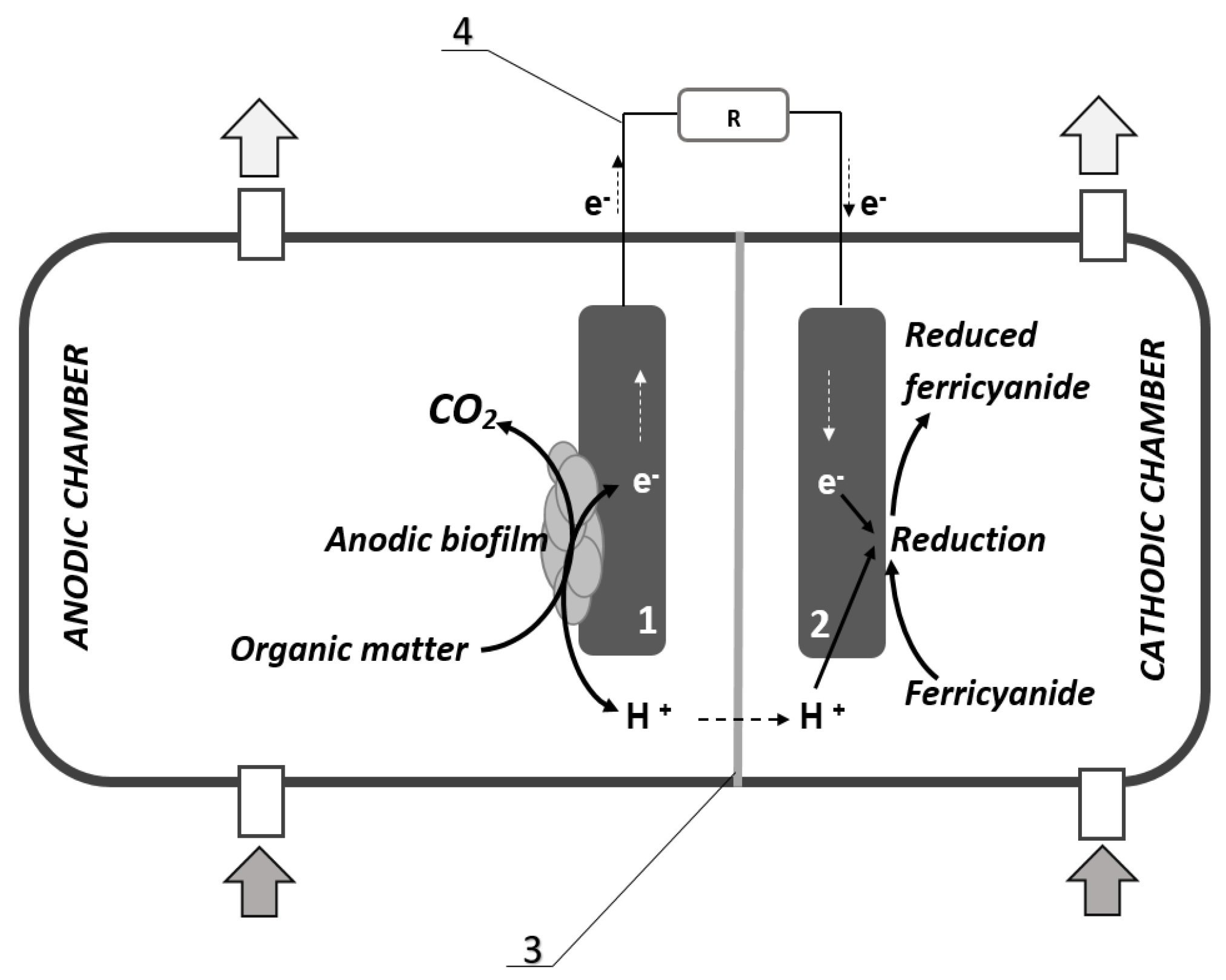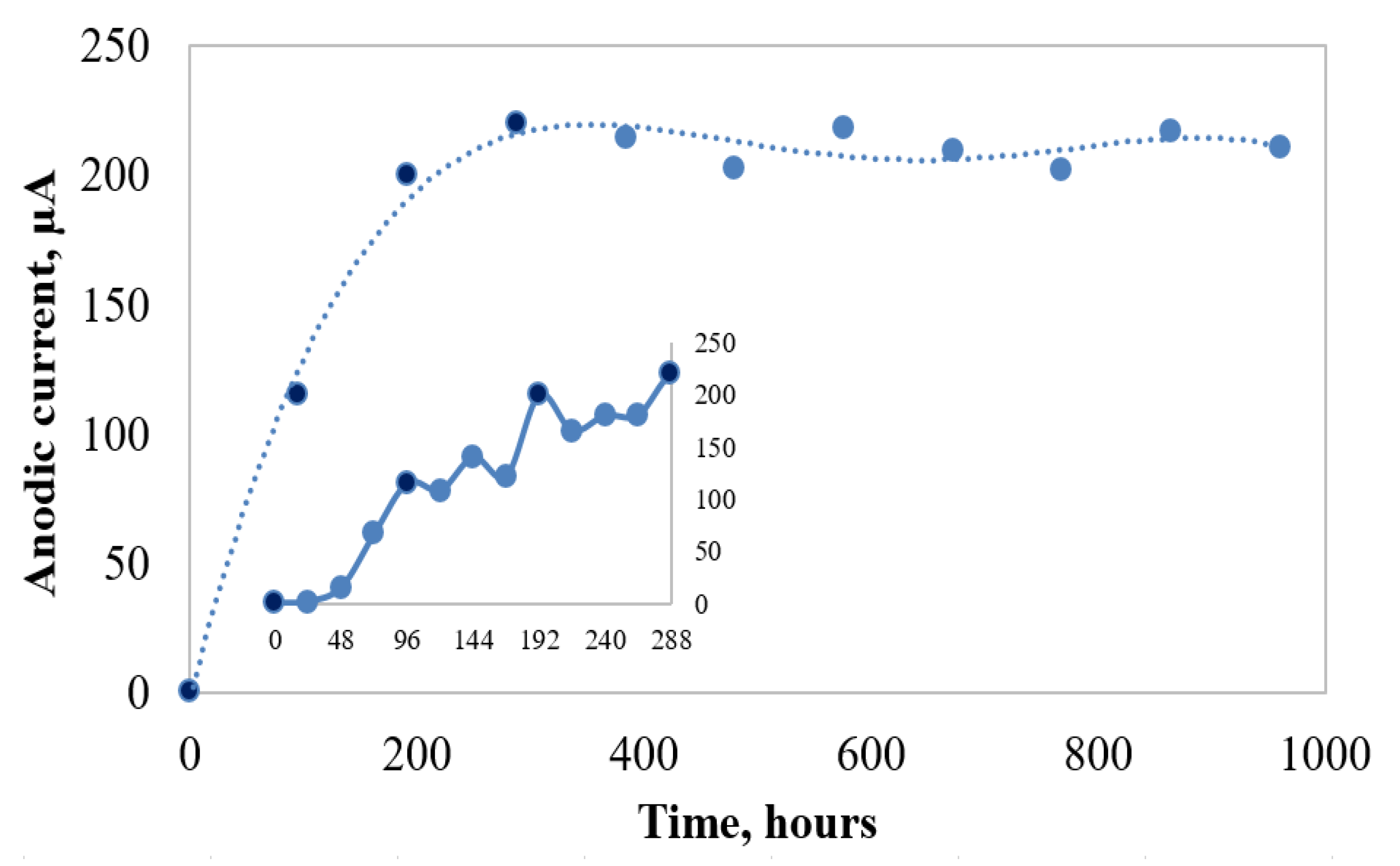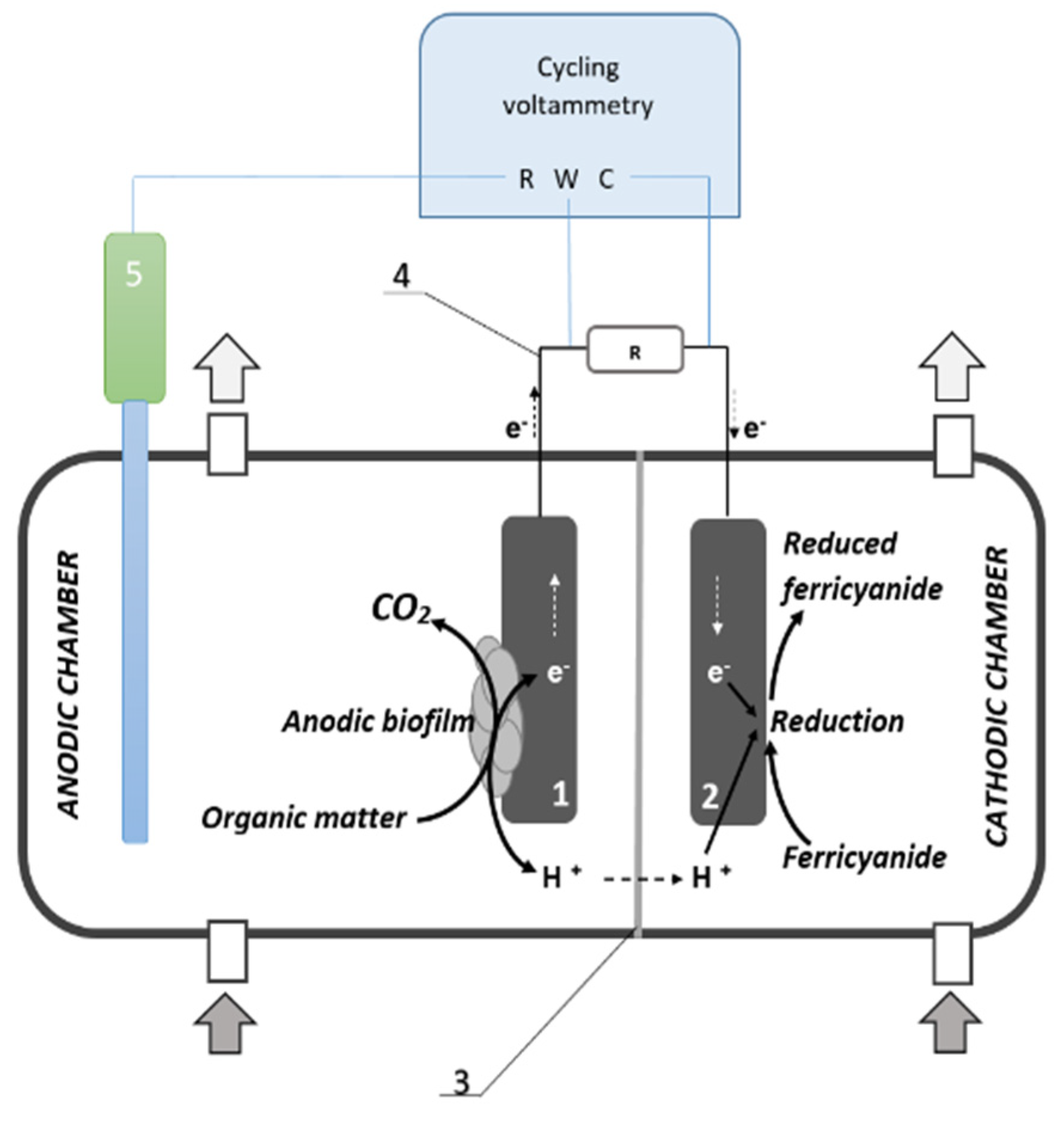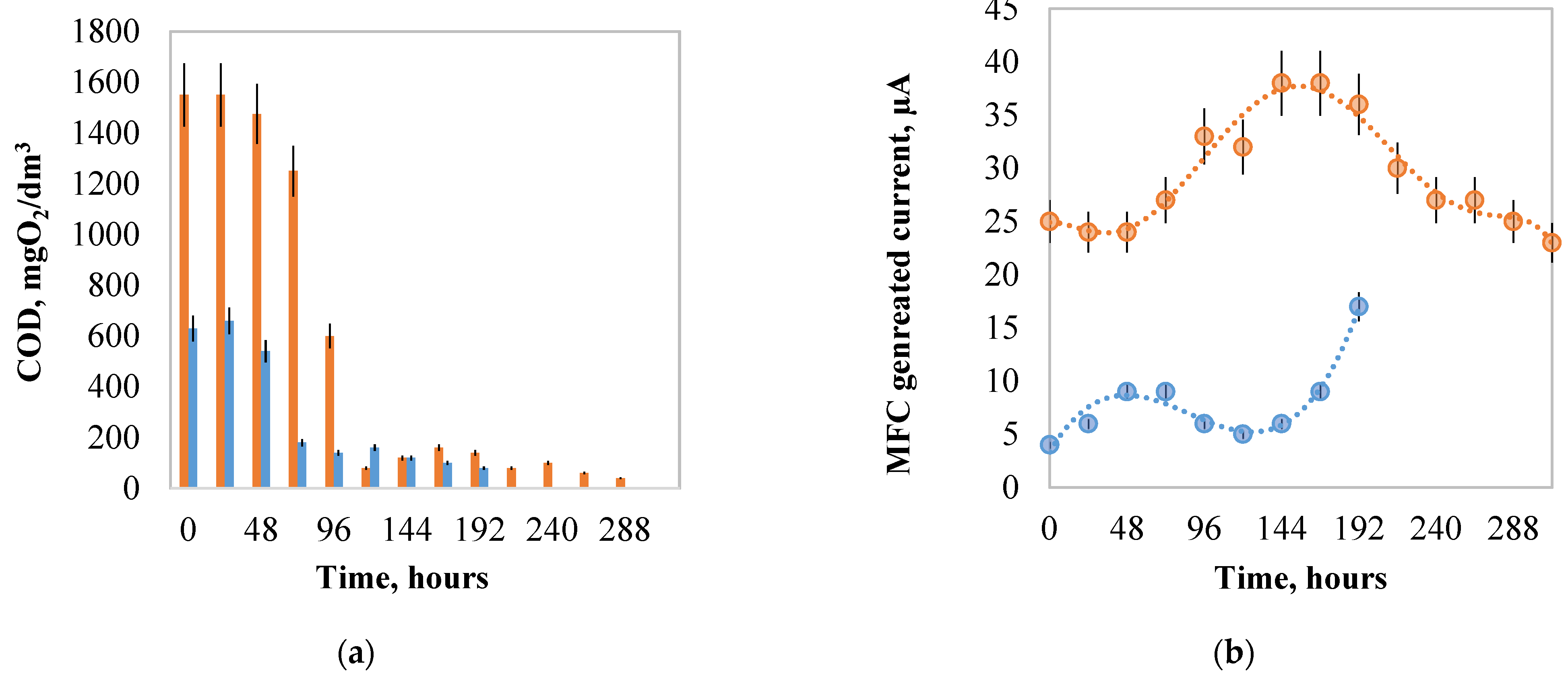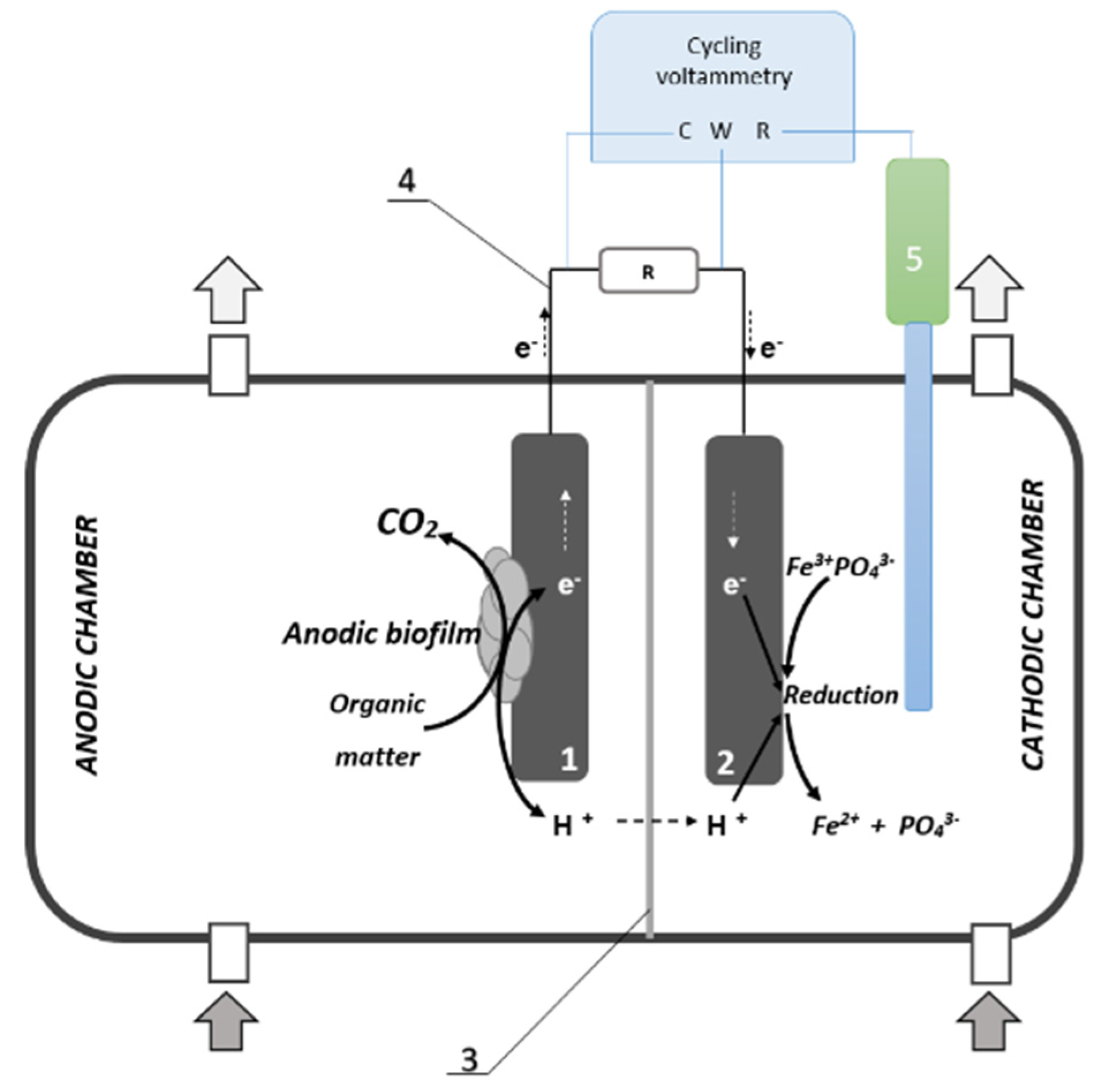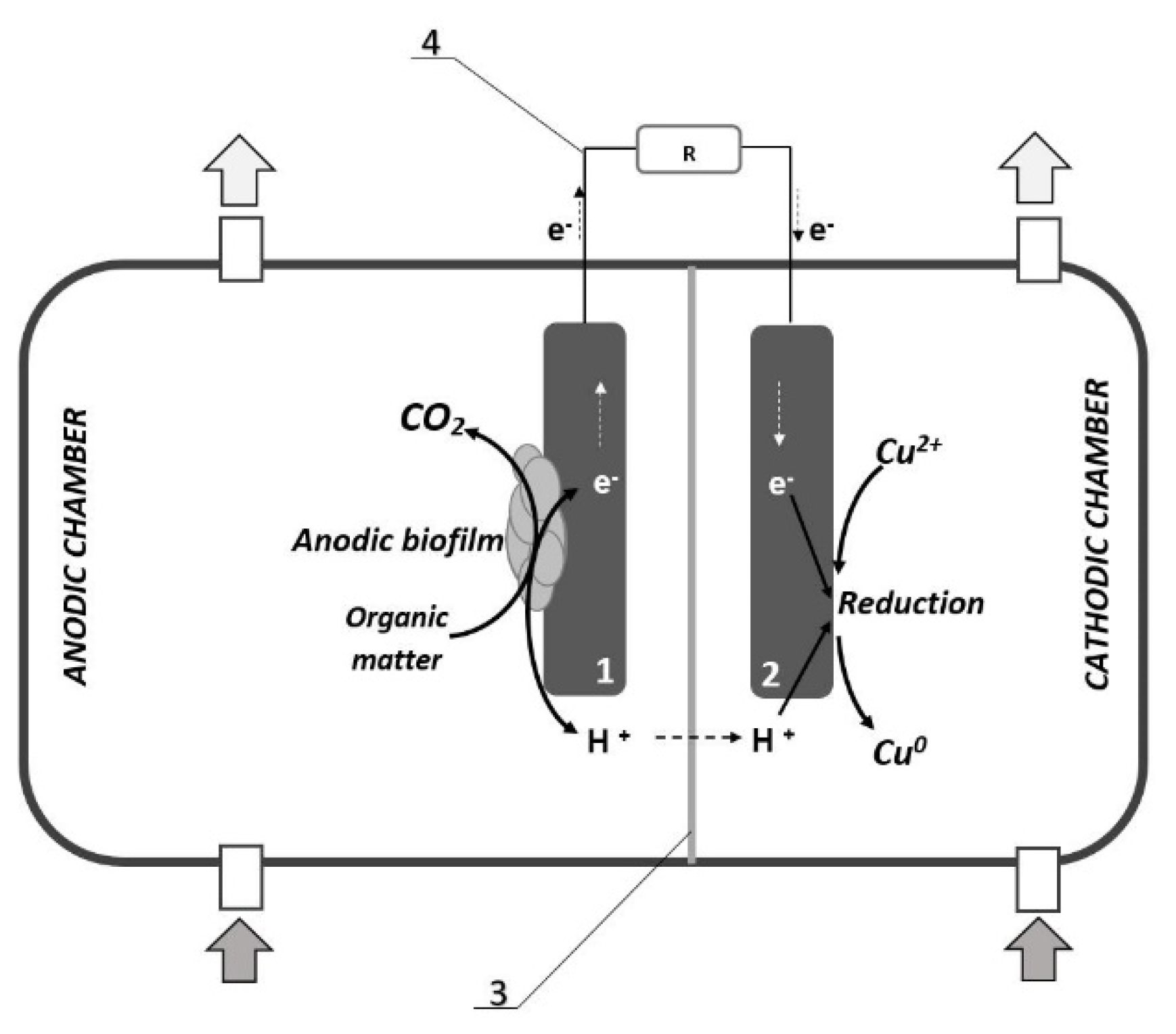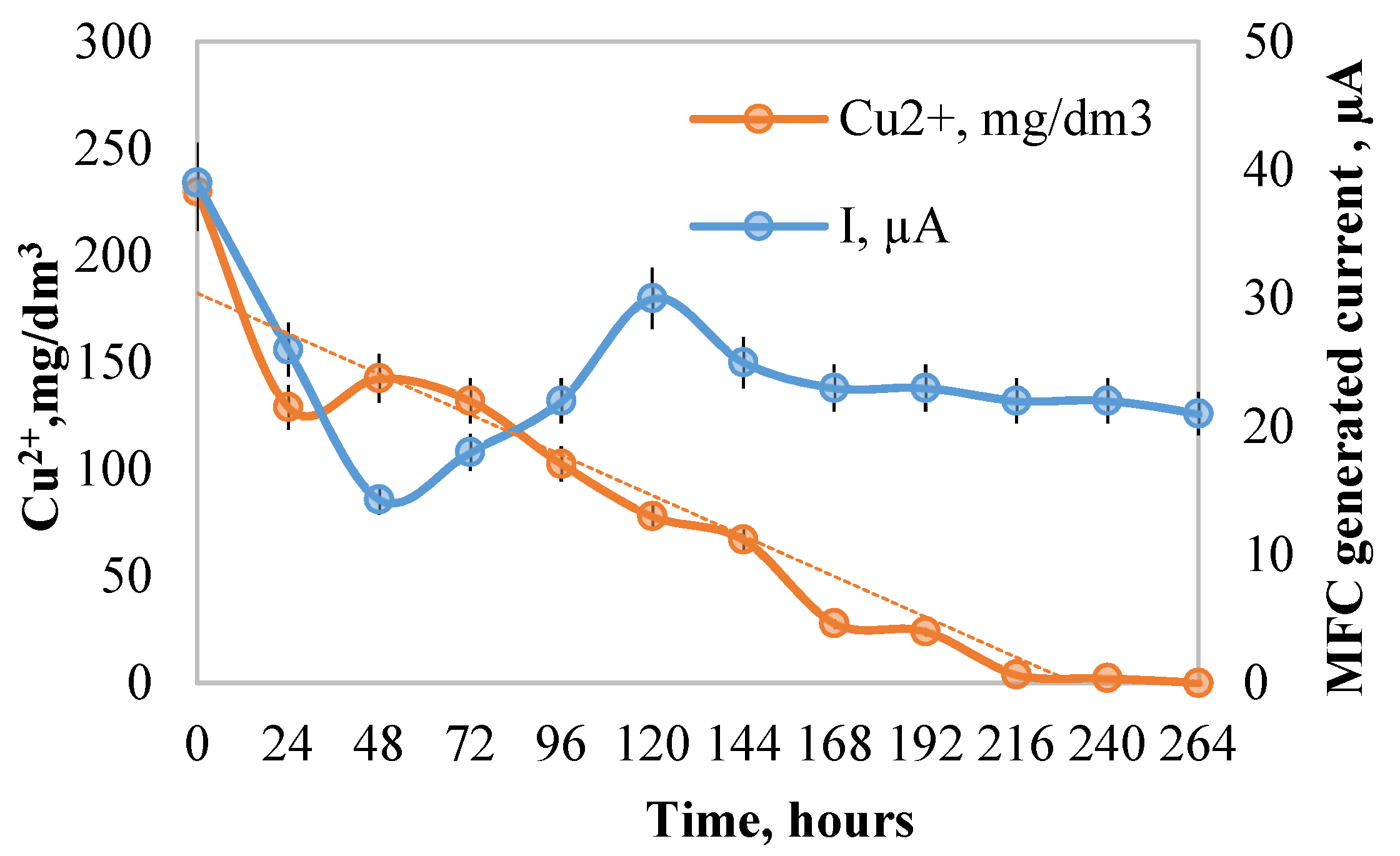1. Introduction
Major challenge in wastewater treatment is to find technological solutions with higher energy yield and lower secondary pollution of the environment. One of the sub-directions is the utilization of organic matter, contained in wastewater and sludge. Anaerobic digestion (AD) is considered to be one of the most effective and efficient methods for the stabilization of waste [
1]. During this treatment, the organic matter in waste is reduced, and some energy is recovered in the form of biogas. As an alternative, bio-electrochemical processes offer many of the benefits of the anaerobic digestion, while avoiding some of the AD drawbacks. MFCs are examples of bio-electrochemical types of reactors, which are intensively studied in the recent years. They combine biological and electrochemical processes, in order to generate electricity, hydrogen, or other useful chemicals from organic substrates, including waste organics. MFCs have attracted interest, following the recent trends of developing sustainable methods and products. They offer simultaneous wastewater treatment and direct electrical energy harvesting, which could significantly improve the water management environmental footprint, in general [
2].
The typical microbial fuel cell usually consists of an anode and cathode, connected by an external circuit and separated in different compartments by a proton exchange membrane (PEM). In the anodic chamber, microbial decomposition (biological oxidation) of organic substrates generates electrons and protons that are transferred to the cathode through the circuit and membrane, respectively (
Figure 1). By transferring electrons from the negative terminal (anode) to the positive terminal (cathode) against a load, an electric current is generated [
3]. On the cathode surface, the electrons react with the final electron acceptor. Mostly O
2 is applied as electron acceptor because of its abundance in nature. Recently, air-cathodes, based on the gas-diffusion layers, are in use, avoiding forced O
2 provision at the cathode. Commonly used catholytes include oxygen, ferricyanide, and permanganate [
4]. From a biochemical point of view, there is fundamental difference between the conventional anaerobic digestion and bio-electrochemical processes, even though both processes are anaerobic. Anaerobic digestion is predominantly fermentative transformation of the substrates, without the involvement of any complex electron transport mechanisms for ATP synthesis. On the contrary, in the microbial fuel cell, a respiratory type of metabolism is implemented, with all the typical energy benefits for the bacterial cell. Anaerobic cellular respiration is similar to aerobic cellular respiration, in that electrons extracted from a fuel molecule (organic substrate or the pollutants in the treated wastewater) are passed through an electron transport system, driving ATP synthesis. The only difference between the two processes is the terminal electron acceptor, due to the absence of oxygen, attributed to the anaerobic conditions.
Other different species can be used as electron acceptor in the cathodic semi-reactions, such as manganese, copper and iron ions, nitrates, sulphate, etc., resulting in their chemical reduction and transformation into a preferable form. Recently, the processes involved in the MFCs were intensively studied as an alternative energy source and method for wastewater treatment. Actually, the main benefit of this technology seems to be in the opportunity to mineralize organic matter to water and CO
2 in anaerobic conditions. This perspective is promising, since more that 50% of the wastewater treatment costs are due to the energy demand of aeration systems [
6]. Another bio-electrochemical modification is the microbial electrolysis cell (MEC), which is functioning at free electron acceptor condition and external potential applied between electrodes. The released protons from biological oxidation are transferred through the proton exchange membrane to the cathode chamber, where the consumption of protons, via hydrogen evolution, results in a local pH increase. Recent studies show that such a reagent-free pH increase can be used in struvite precipitation at the cathode. The anodic and cathodic half-reactions can be used for application in several water purification and treatment processes [
7]. In general, BOD and COD can be reduced in the anode compartment from treated wastewater or, alternatively, excess activated sludge can be stabilized [
8,
9]. Cathodic processes can be applied for denitrification, reduction of metal ions, and production of hydrogen [
10].
Heavy metals pollution is nowadays recognized as one of the most concerning environmental issues, due to their toxicity to the biosphere. In recent years, various physical, chemical, and biological treatment approaches for the removal of heavy metals from wastewater have been largely practiced. These methods include mainly chemical precipitation, coagulation-flocculation, adsorption, membrane filtration, and electrochemical treatment technologies [
11]. However, major setbacks of these technologies include the high cost of operation and large amounts of sludge (in case of precipitation/coagulation processes) that are generated [
12], i.e., the niche for development of both economical and eco-friendly technologies for heavy metal removal and recovery exists [
13].
The recent years of studies have proved that bio-electrochemical technology, which can biocatalyze easily biodegradable organic material at anode to produce protons and electrons that will be accepted by electron acceptor at cathode, is a promising alternative [
14]. Once at the cathode, electrons and protons are used for the eventual oxygen reduction reaction to form water [
15]. While the produced electrons are transferred from the anode to the cathode via an external circuit, the protons issued from the anaerobic respiration diffuse through the PEM, leading to electricity generation. Commonly used catholytes include oxygen, ferricyanide, and permanganate [
4]. Heavy metal-containing wastewaters with high redox potential were proposed as catholytes for metal reduction and treatment. The reduced metal would either be deposited on the cathode, precipitate in the solution or remain in soluble form in the catholyte, based on its chemistry [
10].
The MEC technique has a great potential to remove heavy metals, such as nickel, zinc, chromium, and copper in MFC [
10]. Copper especially is regarded as one of the toxic metals causing many health hazards and harmful effects on human beings due to its wide occurrence in mine drainage wastewater. In addition to numerous treatment technologies developed for copper removal [
16], it will be favorable to achieve copper recovery for reuse and recycle in industry, especially in wastewater with low copper concentrations. The high reduction potential of Cu
2+ (+0.34 V vs. SHE) indicated that electricity production and copper recovery can be achieved simultaneously through the MFC. Experimental proofs of removal and recovery of metals, such as Cr(VI), V(V), and Cu(II), using both single and double chambered MFCs, have been reported [
17].
However, besides the successes in MFC copper removal a number of challenges such as low production rates and limited efficiencies make the application of this technology restricted to lab scale only [
18]. Obviously, efforts towards optimization of the microbial fuel cells processes applied in in the treatment of heavy metals, in particular copper contaminated wastewater are needed.
Summarizing the above, it is clear that the bio-electrochemical processes offer a promising alternative of the conventional processes for wastewater treatment. The paper describes three different case studies of bio-electrochemical processes applied for water depollution and resource recovery, based on the implementation of MFC, namely the processes for organic matter, copper, and phosphates removal/recovery.
3. Results and Discussion
3.1. Wastewater COD Removal in MFC
The majority of the pollutants in wastewater are organic compounds. The typical approach toward this pollutant is based on the ability of microorganisms to utilize them as a substrate. Conventionally applied aerobic and anaerobic wastewater treatment methods have many disadvantages, such as high energy demand, production of huge amount of residual sludge, or requirement for temperature control and heating, which could elevate the environmental footprint of the wastewater management. MFC offers an alternative, which could minimize the sludge production and avoid the need of forced aeration. This could reduce 60–70% of the costs associated with the wastewater treatment.
To monitor the anode biofilm formation and activation, electrochemical measurements and cyclic voltammetry were applied, in order to detect the so-called anode reduction current, which is a result of the electron flow between the substrate/bacteria system and anode surface. The data obtained demonstrated that the biofilm development follows the typical microbial dynamics curve, with short initial lag phase and exponential grow and activation within the first 240 h of the process (
Figure 2). The current values increase after the inoculation, indicating a change in the electrochemistry of the anode, related to the electrode colonization and biofilm formation. The biocatalytic current reaches its maximum of 219.39 µA at 288 h and remains relatively constant for another 29 days (696 h). Reaching a plateau after a certain period of time, under constant operating conditions, is usually associated with the successful colonization of the electrode and the electrochemical stabilization of the system. MFC reactor configuration and experimental design used during the COD removal experiments is shown in
Figure 3.
In order to test the MFC capacity, two different experiments were carried out to simulate the COD removal and energy recovery during the treatment of model wastewater, with COD 0.6 and 1.6 g O2·dm−3.
The results (
Figure 4a) obtained show that the mineralization processes follow the typical degradation dynamics, and, initially, the COD values increase slightly. This is known to be a sign of the enzymatic hydrolysis of complex organic compounds in the medium at the very beginning of the microbial utilization [
19,
20]. Both cases of low and high organics-containing wastewaters treated are effectively mineralized with high COD removal efficiency.
These results confirm our preliminary data obtained during direct comparison of MFC and conventional anaerobic digestion as methods for utilization of highly polluted wastewater. In both cases, a high COD removal efficiency (above 95%) was observed [
21]. However, it was found that the anaerobic digestion requires significantly shorter treatment time to achieve this effect. Given that, anaerobic degradation is a process that has been very well-integrated in the industry for years, it has reached high advanced technical and technological state of development in terms of equipment design and process control and optimization, so these results are not unexpected. By the other side, the MFC technology is largely promising new concept, even though most of studies are based on lab prototypes. In certain stages of the biodegradation process in the MFC the maximum (instantaneous), COD removal rates observed in the MFC reactor are almost two times higher than the anaerobic digestion, reaching 722 mg/dm
3/day, which clearly demonstrates the potential of bio-electrochemical methods [
21]. The MFC technology probably hides significant opportunities that can be developed by optimizing both the technique (design) and the process parameters. Another positive characteristic of MFCs is the almost twice lower yield of excess sludge during the water treatment process, which can be a great technological advantage, given the fact that residual sludge in a secondary waste flow, which have to be managed and processed. In addition, MFCs offer a potential opportunity to recover energy from waste directly in the form of electricity, avoiding the additional technological stages, such as burning biogas to harvest energy [
21].
The electrical measurement and data obtained in the experiment demonstrate different performance of the MFC when wastewater with high and low initial COD is utilized. As a general statement, the higher organic content is associated with better electrical performance. However, in the final stages of the process the behaviour of the MFC reactor with the lower COD feed is significantly different and demonstrated a sustainable tendency to generate higher current, reaching values close to those observed in the MFC, with the more concentrated substrate. Anyway, the maximum current values (35–38 µA), observed during this set of experiments, were measured in the reactor with the higher initial COD at the middle stage of the process (
Figure 4b).
3.2. Phosphate Recovery in MFC by Cathode Reduction of Iron Phosphate and Mobilization of Ortho-Phosphates from Residual Sludge
The widely used chemical phosphorus removal during the wastewater treatment locks the phosphates, in the form of insoluble compounds, such as ferric phosphate (Ferric salts are used for coagulation) and makes direct P recovery impossible. MFC technology could be used to address this problem by reduction of the iron ions (form the active Fe(III) to inactive Fe(II) state), which will eventually result in mobilization of the phosphate ions. This reduction could be performed in the cathode chamber of the bio-electrochemical reactor if the electrochemical conditions needed are presented.
In this experiment, a MFC and cyclic voltammetry are used to study the dynamics and electrochemical mechanisms of phosphate mobilization form model suspension of ferric phosphate (
Figure 5). The anode chamber was continuously fed with substrate in order to provide stationary conditions and microbial activity. The initial concentration of ferric phosphate in the cathode compartment was 500 mg PO
4·dm
−3. The process was monitored every 24 h, and the concentration of phosphates and cathode current expressing the transfer of electrons towards the Fe
3+ ions are presented on
Figure 6.
The data obtained show that the phosphate mobilization is very intensive in the first 72 h of the process and the speed is gradually reduced in next few days. The maximal concentration of soluble phosphates is reached in 144th hour after the start of the electrochemical mobilization, and then the process converts to opposite direction by fast desolubilization of the phosphates in the medium. The start of this negative tendency is also characterized by reversing the direction of the cathode current measured. In the studied system, the only possibility is that it is related to the autoxidation of the previously reduced iron to the initial Fe3+ state, following precipitation of ferric phosphate.
Probably, this tendency is related to the deterioration of electrochemical conditions in the MFC, due to depletion of electron acceptors in the cathode chamber, which leads to deterioration of physiological condition of electrogenic microorganisms and anode respiration. The positive values of the cathode current shows that the MFC polarization is reversed, due to this conditional changes.
3.3. Treatment of Copper Polluted Water by Reduction and Precipitation in MFC Cathode Reaction
Current wastewater treatment is technically able to remove copper mainly by different sorption or chemical precipitation techniques [
22,
23,
24]. Despite the relatively good efficiency, these methods are not suitable for recovering copper or other valuable metals from the treated water, and they have significant environmental footprints [
25,
26].
In this study the concept of water treatment by cathodic reduction of Cu2+ to elemental copper—Cu0 in MFC was studied as an alternative approach, which enables simultaneous copper removal and recovery.
The cathode chamber of operating MFC reactor was filed with solution of CuSO
4 at initial concentration of Cu
2+ 200 mg dm
−3. The dissolved copper ions amount was monitored every 24 h by sample collection and analysis (
Figure 7). During the experiment, complete removal of copper ions introduced into the system was observed within 264 h. According to the results obtained, average copper removal rate of 0.9 mg dm
−3 per hour was achieved during the process (
Figure 8).
The dynamics of the copper reduction and removal follows linear tendency; however, in different stages of the process, the reduction rate could be different form the observed average and maximum rates. Following the conclusions made during the phosphate mobilization experiments, the process speed deterioration during the final stages could be related to the same reasons, a limited amount of electron acceptors for the cathode reaction (in this specific case the copper ions itself) leads to general inhibition of the MFC electrochemistry and anode biofilm biochemical activity.
